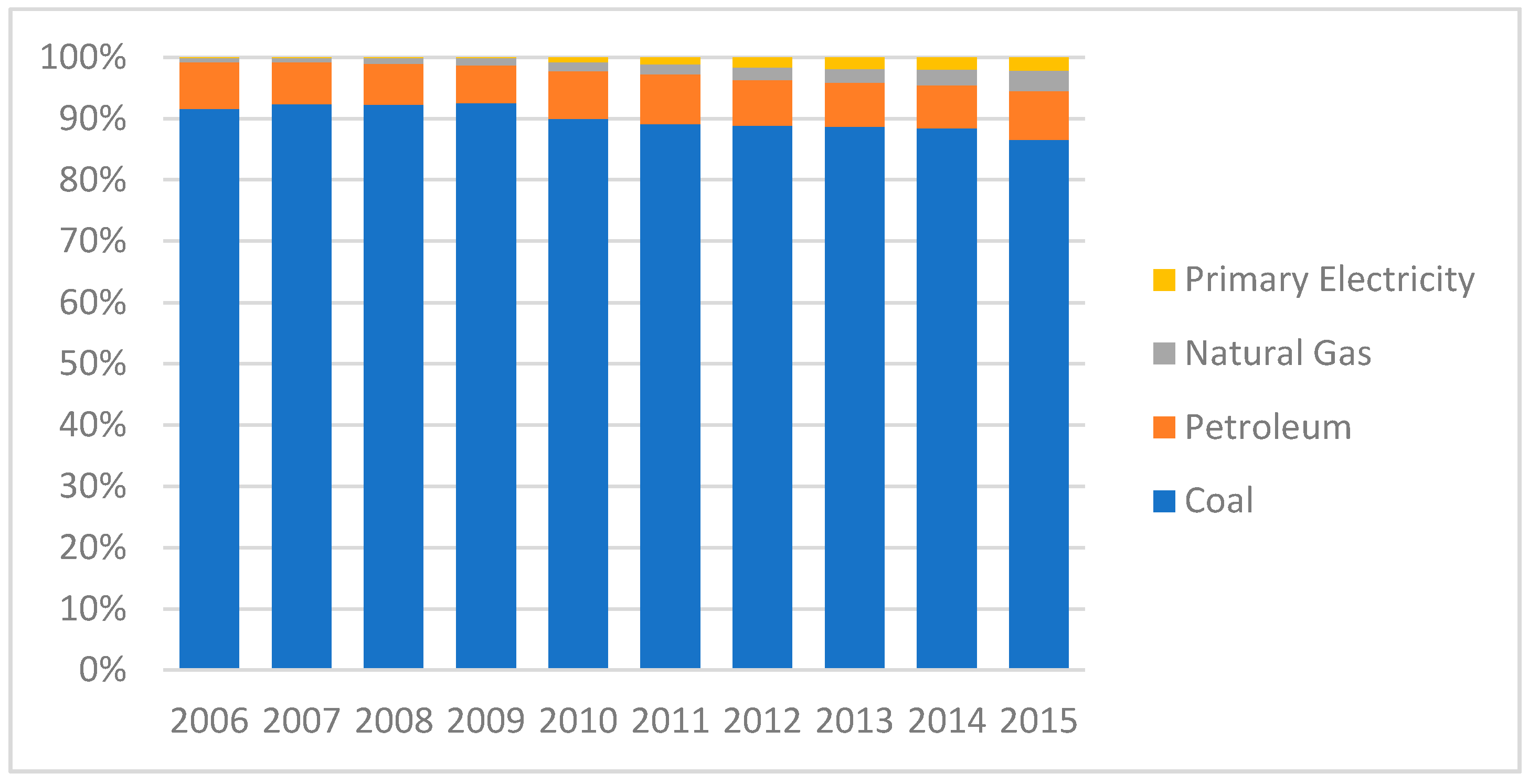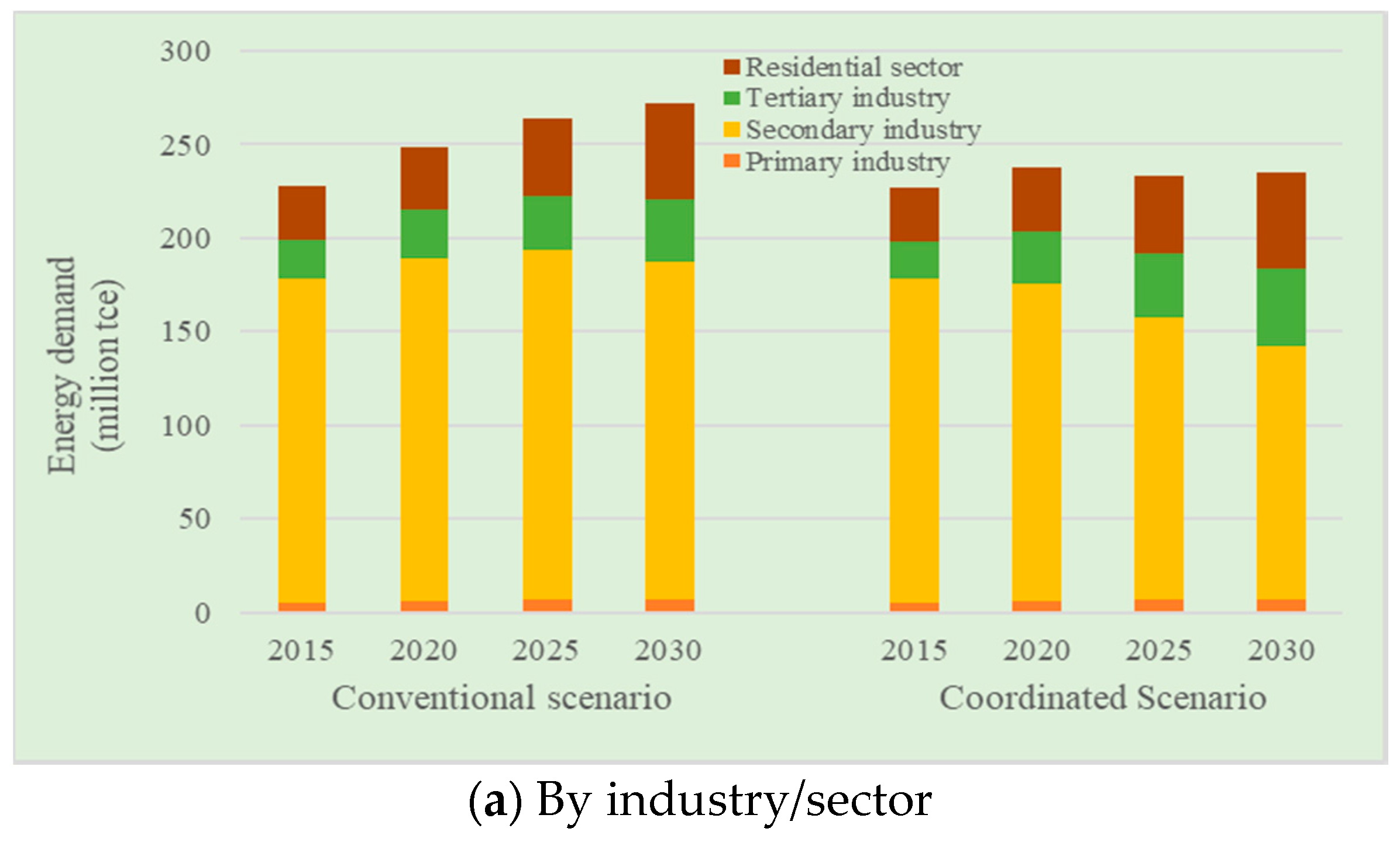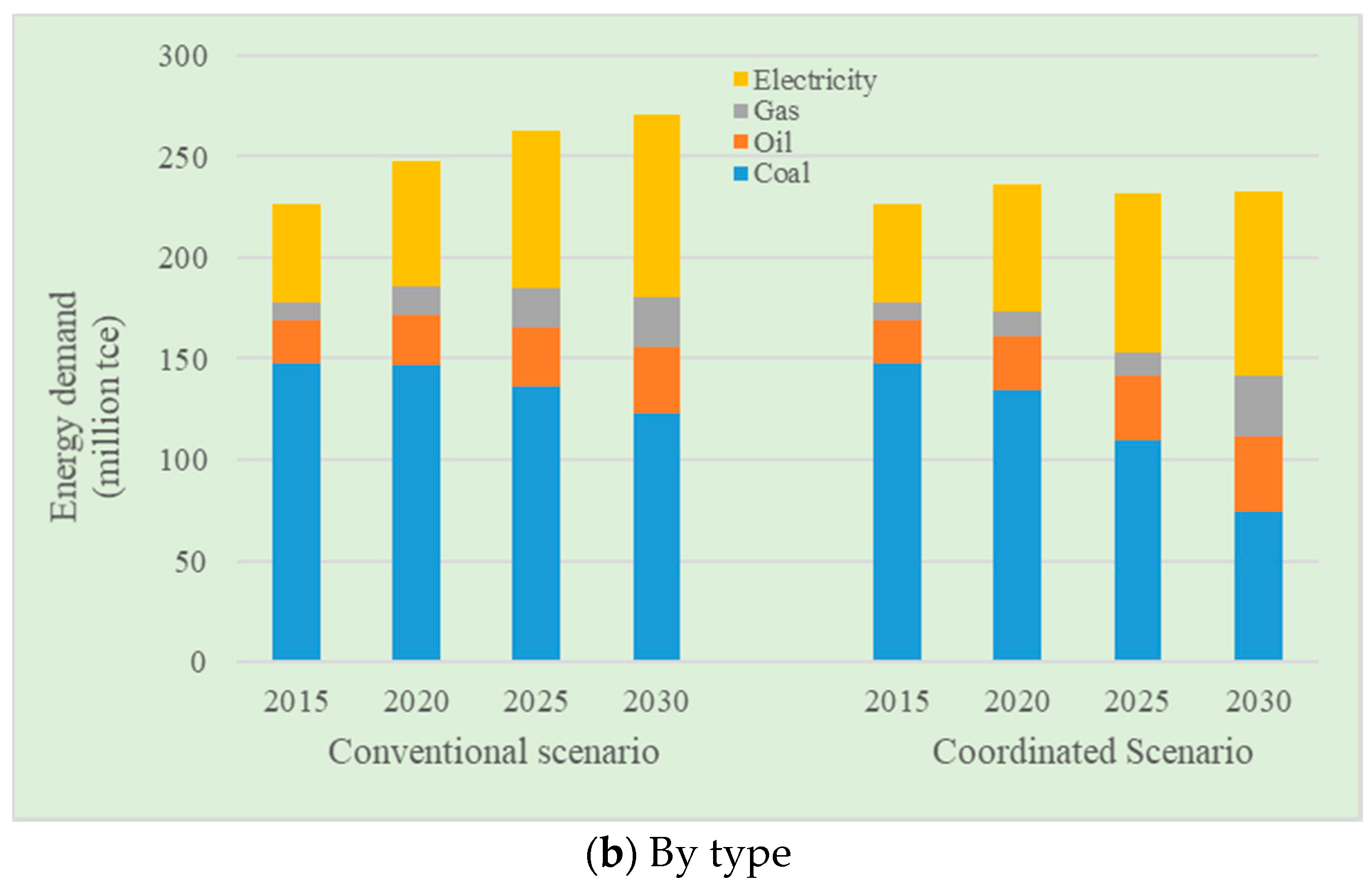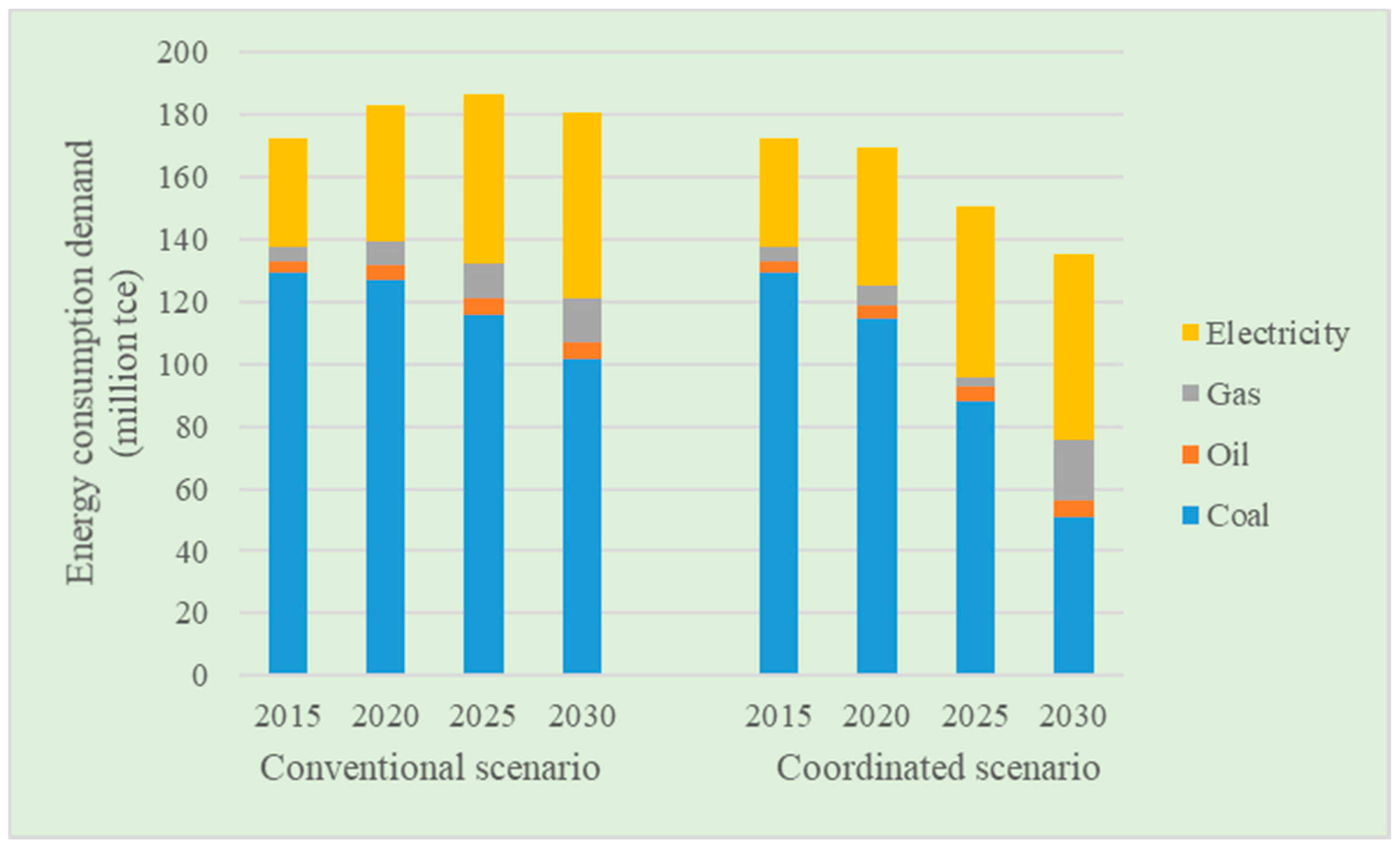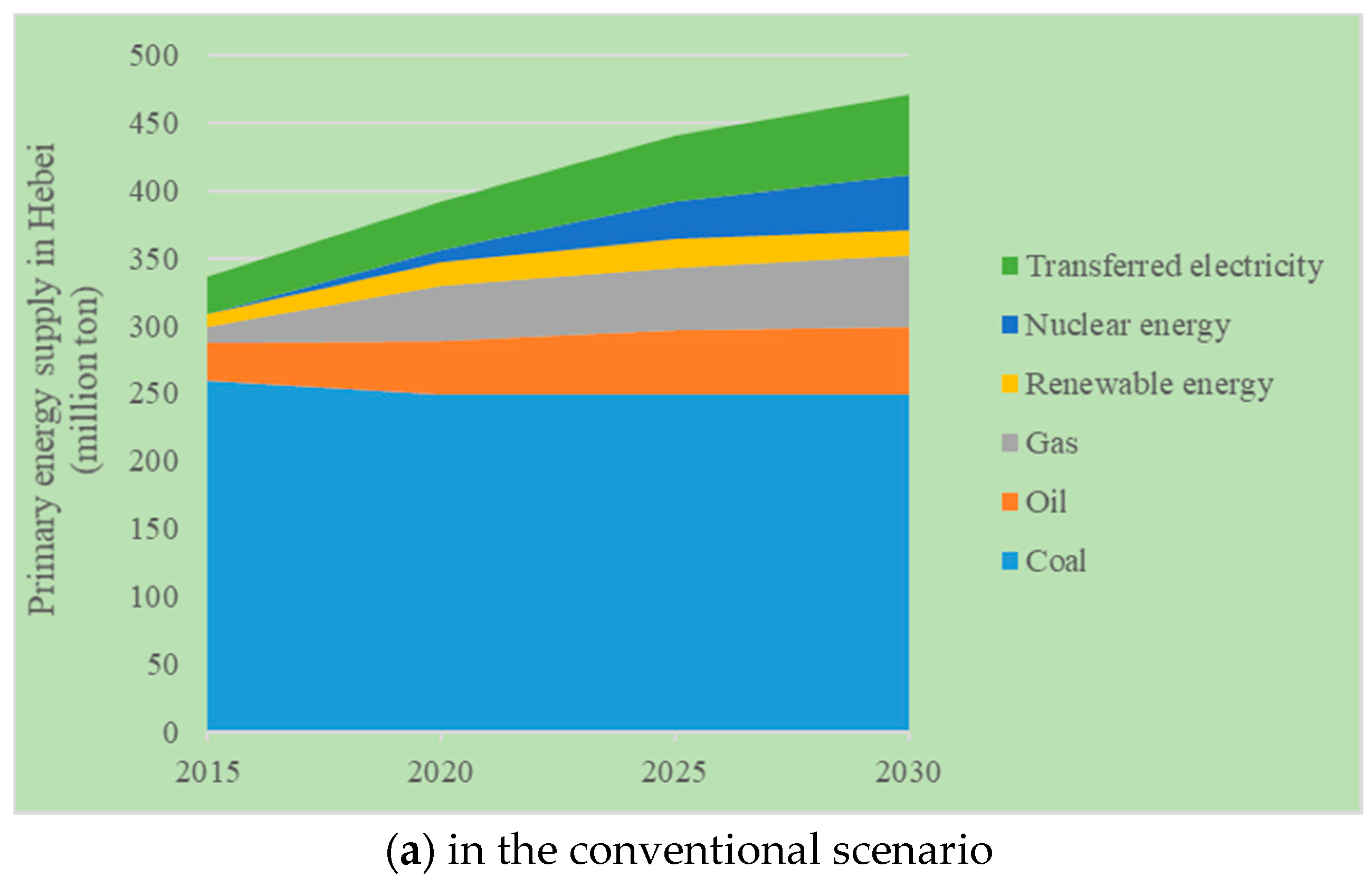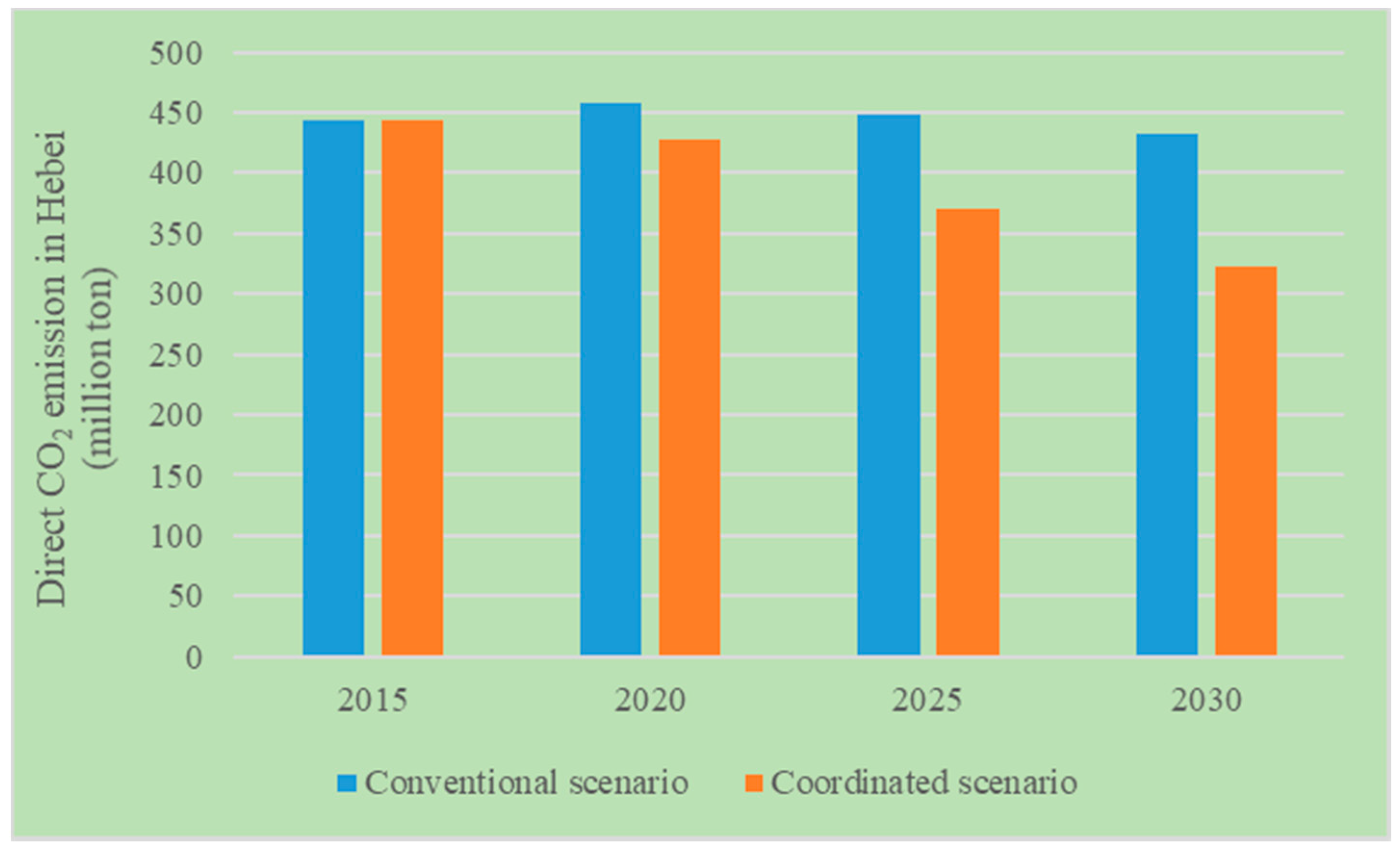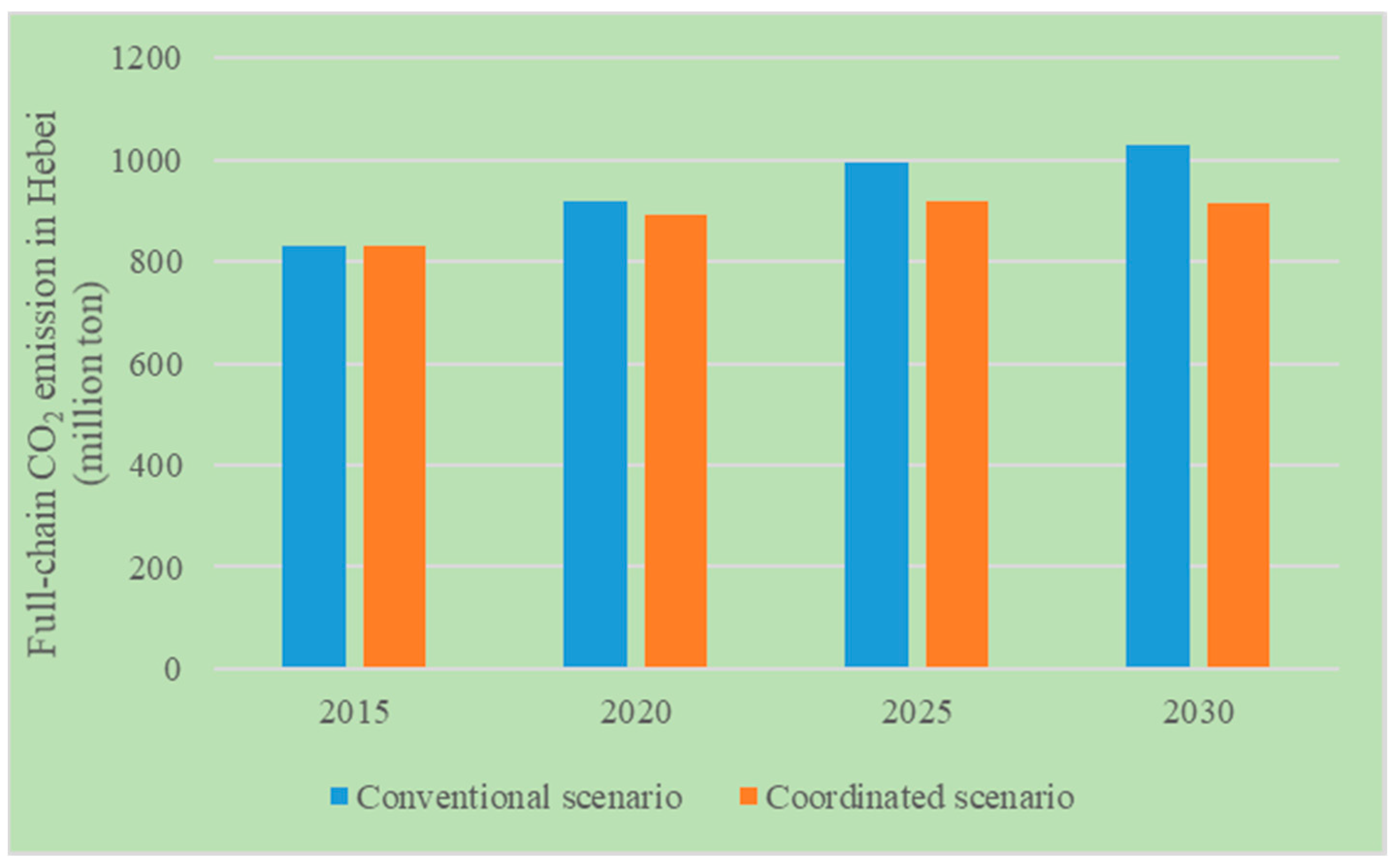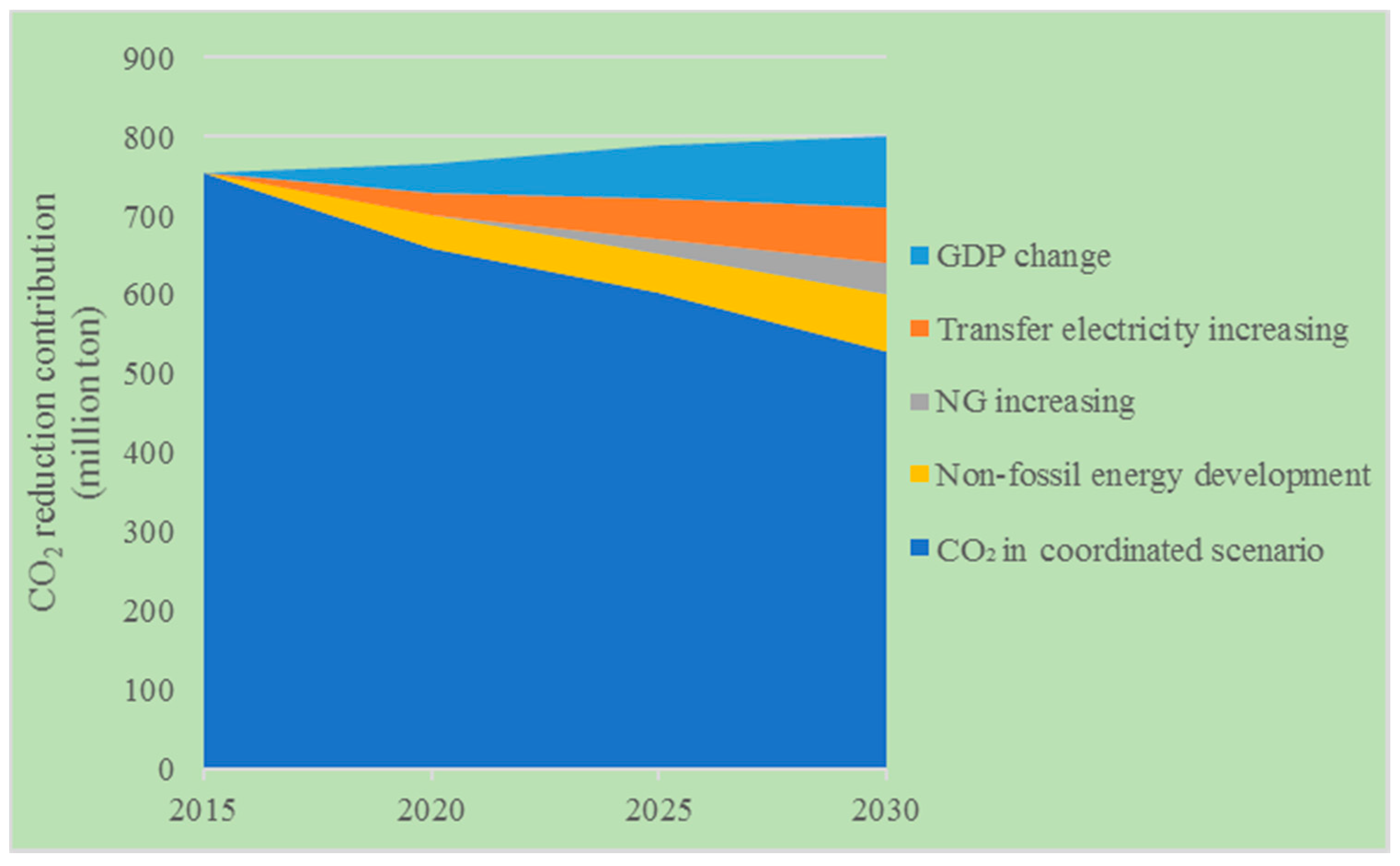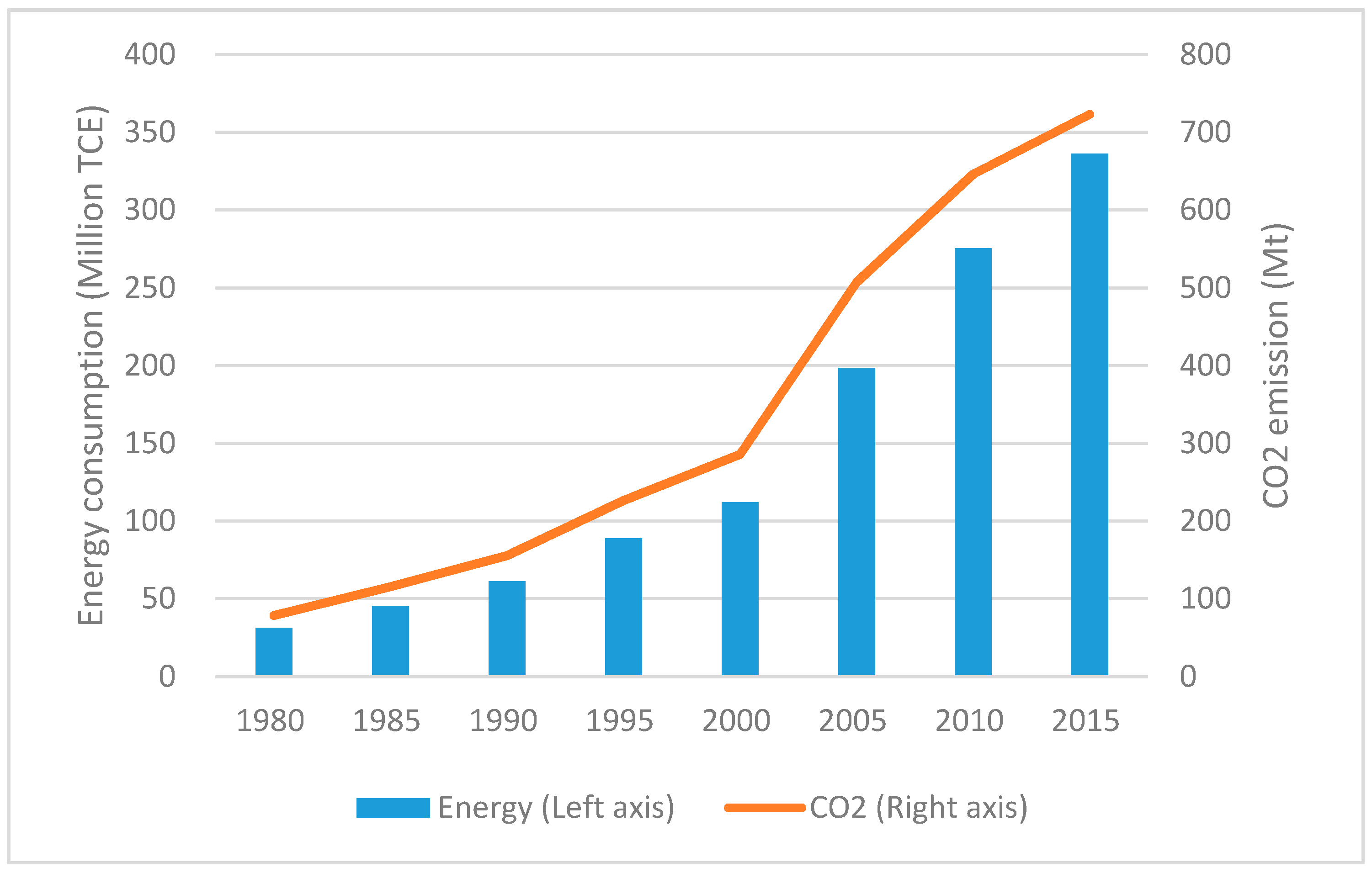5.1. Results of End-Use Energy Consumption
(1) Total end-use energy demand
Table A1 and
Table A2 and
Figure 5 indicate end-use energy consumption by industry/sector and fuel type in the conventional and coordinated scenarios.
In the conventional scenario, the total end-use energy consumption in Hebei will increase from 228 million tce in 2015 to 272 million tce in 2030, and the growth ratio will be 19%. The ratio of energy consumption of secondary industry will drop from 76% to around 66% in 2030. Coal will be gradually replaced by gas and electricity. Therefore, its proportion among the total energy consumption will decrease from approximately 65% in 2015 to 45% in 2030.
In the coordinated scenario, the total energy consumption in Hebei in 2030 can be 235 million tce (about 37 million tce less than that in the conventional scenario). Energy structure can be sufficiently optimised, since the proportion of secondary industry sector’s energy consumption among the total energy consumption can drop to below 60%, and the proportion of coal among the total energy consumption can decrease to 32% in 2030, which are much better than the results in the conventional scenario.
Coal utilisation of end-use energy consumption in the coordinated scenario is 40% below that in the conventional scenario, while natural gas utilisation in the coordinated scenario is 23% more than that in the conventional scenario, resulting from gradually incremental utilisation of natural gas substituting the direct use of coal.
Oil utilisation of end-use energy consumption in the coordinated scenario is 12% more than that in the conventional scenario, while electricity utilisation in the coordinated scenario is 2% more than that in the conventional scenario, resulting from growth of the tertiary industry.
(2) Primary industry
It can be estimated that future energy demand in primary industry of Hebei will remain stable, from about 6 million tce in 2015 to 7 million tce in 2030.
(3) Secondary industry
In the conventional scenario, energy consumption of the secondary industry in Hebei will gradually increase, from 172 million tce in 2015 to 183 million tce in 2020, and then 181 million tce in 2030 as
Figure 6 shows. Energy structure of the secondary industry in Hebei is based on coal and electricity, at the proportions of 75% and 20%, respectively, in 2015; the proportions of oil and gas were lower, at 2% and 3%, respectively. Owing to the increase in non-energy-intensive industry energy consumption, particularly the substantial increase in the proportions of oil and gas in non-energy-intensive sub-industries, the proportion of gas in the electricity sub-industry will increase markedly; the proportions of coal, electricity, oil, and gas in 2030 will be 56%, 33%, 3%, and 8%, respectively.
In the coordinated scenario, total energy consumption of the secondary industry sector will decrease, reaching 170 million tce in 2020 and 135 million tce in 2030. In 2030, proportions of coal, electricity, oil, and gas will be 38%, 44%, 4%, and 14%, respectively. In the coordinated scenario, the proportion of energy consumption will decrease by 39% for coal and increase by 24% for electricity; the increases for oil and gas will be 2% and 12%, respectively, in 2030 compared with 2015.
Energy consumption of energy-intensive industries accounted for 80% of total energy consumption of the secondary industry sector in 2015. In the conventional scenario, the proportion will drop to about 60% and about 50% in 2020 and 2030, respectively; in the coordinated scenario, to about 55% and 40% in 2020 and 2030, respectively.
(4) Tertiary industry
End-use energy demand of the tertiary industry in Hebei is estimated to grow from 21 million tce in 2015 to around 33–41 million tce in 2030; a growth rate of around 56–106%. This study shows that energy demand in tertiary industry will rapidly increase, and its proportion in total energy demand will increase from 9% in 2015 to around 12–18% in 2030.
(5) Residential sector
Future energy demand of Hebei residents in Hebei is estimated to grow from 29 million tce in 2015 to 51 million tce in 2030 with a growth rate of around 75%. This study shows that future energy consumption of Hebei residents will also increase rapidly, with increasing demand for electricity, oil and gas, among the different types of high-quality energy.
5.3. Results of Primary Energy Supply Structure in Future
Primary energy supply in future will be more diversified and cleaner in the defined two scenarios as shown in
Table A3 and
Figure 8.
Coal consumption used to be 314 million tons (equivalent to 260 million tce) in 2015, and will decrease to 150 million tons (equivalent to 125 million tce) in 2030 in the coordinated scenario, merely accounting for about 30% of total energy supply.
Utilisation amount of natural gas will increase from 8.5 billion cubic meters in 2015 to 40–65 billion cubic meters in 2030, and account for 10–20% of total energy consumption.
Utilisation amount of electricity transferred from other provinces will increase rapidly, and its proportion among total electricity consumption will increase from 28% in 2015 to over 30% in 2030. The quantity will increase from 90 trillion kWh in 2015 to 200–300 trillion kWh.
As for nuclear power, several nuclear plants will be put into production from 2020, and the proportion of nuclear power among total electricity supply will be 14% and 28% in 2020 and 2030, respectively.
Energy supply from renewable energy will develop smoothly, increasing from 10 million tce in 2015 to about 20 million tce in 2030. As
Table A4 indicates, in the conventional scenario, non-fossil energy supply ratios in Hebei are 7% and 13% in 2020 and 2030, respectively. In contrast with the conventional scenario, the non-fossil energy supply ratios in the coordinated scenario fulfil the goal set by Chinese government and reach the average level in the country.
5.4. Results of CO2 Emission
(1) Direct CO2 emission
As
Figure 9 indicates, in the conventional scenario, direct CO
2 emission will increase slightly from 444 million tons in 2015 to 456 million tons in 2020, and then peak, decreasing to 432 million tons in 2030. In the coordinated scenario, direct CO
2 emission will constantly decrease from 444 million tons to 323 million tons in 2030, the rate of descent reaching 27%.
(2) Full-chain CO2 emission
In the conventional scenario, full-chain CO
2 emission will increase from 831 million tons in 2015 to 1027 million tons in 2030, and the growth ratio will reach 24%, while, in the coordinated scenario, full-chain CO
2 emission peaked in 2025, and will constantly decrease to 916 million tons in 2030. Detailed results are shown in
Figure 10.
It should be noted that CO
2 emission of electricity transferred from other provinces is considered here. The CO
2 emission factor of electricity adopted here is that in the north China electricity grid, which Hebei electricity grid is affiliated with [
37]. CO
2 emission of electricity transferred from other provinces account for about 10% of total full-chain CO
2 emission in Hebei.
(3) Accounted CO2 emission
The accounted CO
2 emission in Hebei in 2015–2030 is shown in
Table A4. In the conventional scenario, CO
2 emission will increase from 723 million tons in 2015 to about 800 million tons in 2030, and the growth ratio will reach 10%, while, in the coordinated scenario, CO
2 emission will constantly decrease to 528 million tons in 2030.
Accounted CO
2 emission, which is reported to the central government of China, can be calculated following the standard process [
38] by counting up each type of end-use energy consumption multiplied by homologous CO
2 emission factor. The projection of electricity CO
2 emission factor is important during the accounted CO
2 emission calculation. Electricity CO
2 emission factors are different in different regions’ power grids in China. The emission factors of electricity used in Hebei in 2015, 2020 and 2030 are 0.837, 0.755 and 0.725 kg/kWh, respectively, same as North China Power Grid, which Hebei is attached to [
38].
5.5. CO2 Reduction Contribution Analysis
It should be noted that clean trend of energy structure can help reduce CO2 emission resulted from energy consumption, especially when nuclear power and electricity generated from renewable energy are promoted. CO2 emission in the coordinated scenario will keep decreasing, since nuclear power and electricity generated from other renewable energies will bring zero CO2 emission.
Supposed that CO
2 emission from electricity in Hebei is calculated based on its actual production status, CO
2 emissions from 2015 to 2030 in Hebei are shown in
Figure 11. Comparing CO
2 emissions in the coordinated scenario with that in the conventional scenario, the reduction ratios will be 14%, 23% and 34% in 2020, 2025 and 2030, respectively.
GDP changes will maintain about 1/3 of contribution to CO2 emission reduction in the long run. Increasing transferred electricity’s contribution to CO2 emission reduction will gradually increase, and turn out to be about 1/4 in 2030. In the short term, non-fossil energy development will be the most effective method to reduce CO2 emission, since non-fossil energy development can sharply reduce the demand of coal electricity, and it will account for about 40% and about 70% of CO2 emission reduction in 2020 and 2030, respectively.
5.7. Comparison of CO2 Emission and Energy Structure in Hebei and Whole China in Future
As
Table A4 shows, Hebei’s CO
2 emission (accounted number following the inventory guideline) has peaked in the year of 2015 and will decrease about 30% from 2015 to 2030 in the coordinated scenario, accompanied by lower proportion of coal and higher of non-fossil energy in the energy structure than in in conventional scenario. The proportion of coal (which is carbon intensive) in the total primary energy consumption will fall from around 80% in 2015 to 53% in 2030 and the proportion of non-fossil energy (which is carbon free) will finally grow to 13% in 2030 in the conventional scenario. In the coordinated scenario, the proportion of coal in the total primary energy consumption will fall to about 30% in 2030 and the proportion of non-fossil energy will finally grow to 20% in 2030.
As mentioned in
Section 5.4, according to the calculation method proposed by provincial accounted CO
2 emission reports to the central government of China, indirect CO
2 emissions from transferred electricity is equal to the product of actual quantities of transferred electricity times average emission factor of its regional power grid.
China government has pledged to peak the CO
2 emission around 2030 and planned to enforce the non-fossil energy ratio of total energy consumption to reach 12% and 20% in 2020 and 2030, respectively, while decreasing coal consumption to decrease its proportion in the total primary energy consumption below 50% [
39,
40].
It is found that the effect of energy saving and GHG reduction in future in Hebei can surpass the national average level through efforts to decrease the total energy consumption of Hebei, increase the clean energy and greatly optimise the energy structure in the coordinated development scenario.
